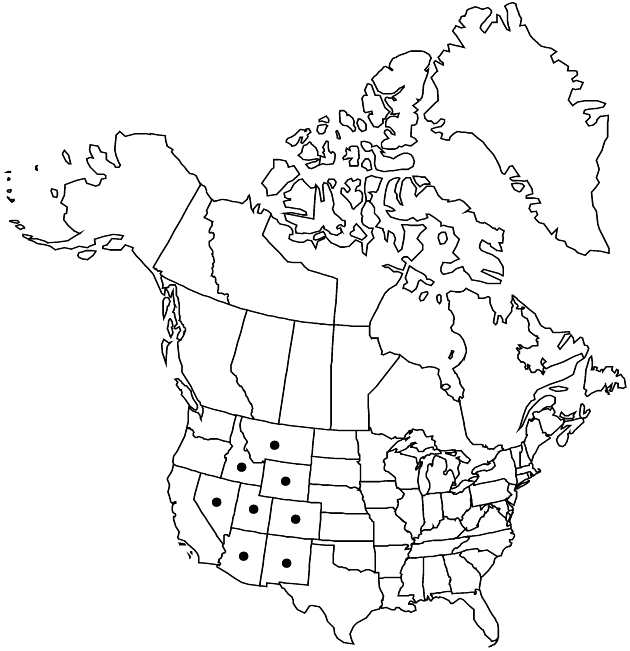Difference between revisions of "Artemisia cana subsp. viscidula"
Rhodora 61: 84. 1959.
FNA>Volume Importer |
FNA>Volume Importer |
||
| Line 15: | Line 15: | ||
|name=Artemisia argillosa | |name=Artemisia argillosa | ||
|authority=(Osterhout) Rydberg | |authority=(Osterhout) Rydberg | ||
| − | }}{{Treatment/ID/Synonym | + | }} {{Treatment/ID/Synonym |
|name=Artemisia viscidula | |name=Artemisia viscidula | ||
|authority=unknown | |authority=unknown | ||
| Line 33: | Line 33: | ||
|elevation=2000–3300 m | |elevation=2000–3300 m | ||
|distribution=Ariz.;Colo.;Idaho;Mont.;Nev.;N.Mex.;Utah;Wyo. | |distribution=Ariz.;Colo.;Idaho;Mont.;Nev.;N.Mex.;Utah;Wyo. | ||
| − | |discussion=<p>Subspecies viscidula is the common silver sagebrush of the intermountain region of western North America. In New Mexico, it is known only from Rio Arriba County. It is distinguished from subsp. bolanderi by geography as well as its darker green foliage and sparsely (rather than densely) tomentose or glabrous stems. Usually restricted to wet meadows and stream banks, it is distinctive in the late summer and fall by its yellowing ephemeral leaves.</p> | + | |discussion=<p>Subspecies viscidula is the common silver sagebrush of the intermountain region of western North America. In New Mexico, it is known only from Rio Arriba County. It is distinguished from <i></i>subsp.<i> bolanderi</i> by geography as well as its darker green foliage and sparsely (rather than densely) tomentose or glabrous stems. Usually restricted to wet meadows and stream banks, it is distinctive in the late summer and fall by its yellowing ephemeral leaves.</p> |
|tables= | |tables= | ||
|references= | |references= | ||
| Line 57: | Line 57: | ||
|publication year=1959 | |publication year=1959 | ||
|special status= | |special status= | ||
| − | |source xml=https://jpend@bitbucket.org/aafc-mbb/fna-data-curation.git/src/ | + | |source xml=https://jpend@bitbucket.org/aafc-mbb/fna-data-curation.git/src/8f726806613d60c220dc4493de13607dd3150896/coarse_grained_fna_xml/V19-20-21/V19_870.xml |
|tribe=Asteraceae tribe Anthemideae | |tribe=Asteraceae tribe Anthemideae | ||
|genus=Artemisia | |genus=Artemisia | ||
Revision as of 16:15, 18 September 2019
Shrubs, 50–70(–90) cm. Stems white (sparsely tomentose) or brown (glabrous). Leaves bright to dull green, blades linear to narrowly lanceolate, (1.5–)2–3 × 0.2–0.4 cm, often with irregular lobes, sparsely hairy or glabrescent, viscid. Heads (2–3 per branch, erect, sessile) in (sparsely leafy) arrays 12–20 × 1–2 cm. Involucres narrowly campanulate, 3–4 × 2–3(–4) mm. Phyllaries narrowly lanceolate, acute (outer) or obtuse, sparsely hairy. Florets 4–8. Cypselae 1–2.3 mm. 2n = 18, 36, 72.
Phenology: Flowering mid–late summer.
Habitat: Wet mountain meadows, stream banks, rocky areas with late-lying snows
Elevation: 2000–3300 m
Distribution

Ariz., Colo., Idaho, Mont., Nev., N.Mex., Utah, Wyo.
Discussion
Subspecies viscidula is the common silver sagebrush of the intermountain region of western North America. In New Mexico, it is known only from Rio Arriba County. It is distinguished from subsp. bolanderi by geography as well as its darker green foliage and sparsely (rather than densely) tomentose or glabrous stems. Usually restricted to wet meadows and stream banks, it is distinctive in the late summer and fall by its yellowing ephemeral leaves.
Selected References
None.